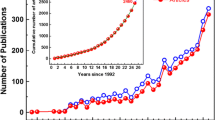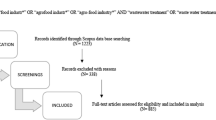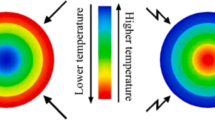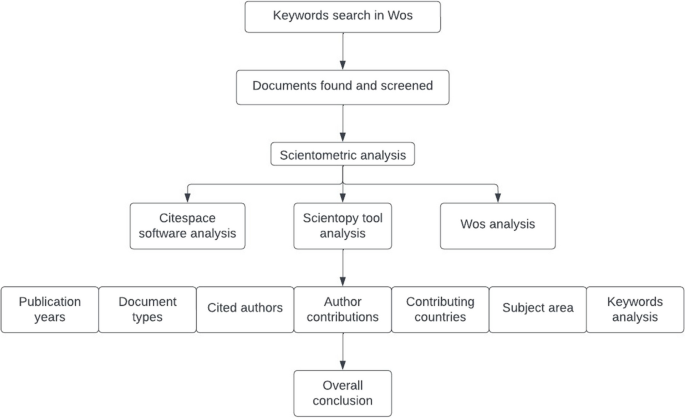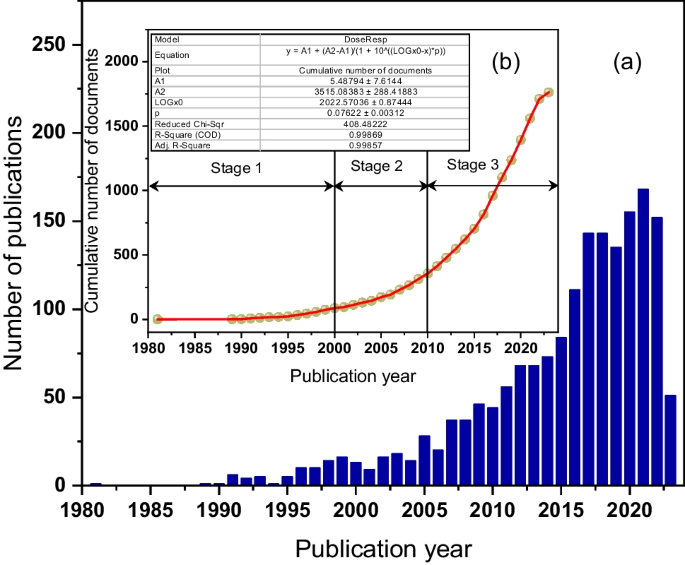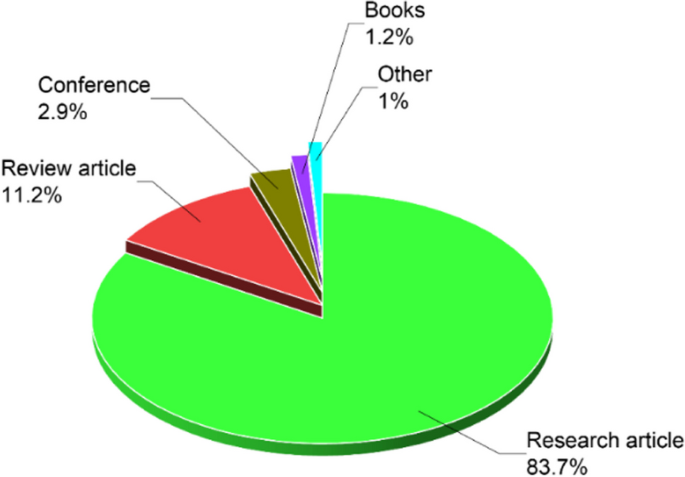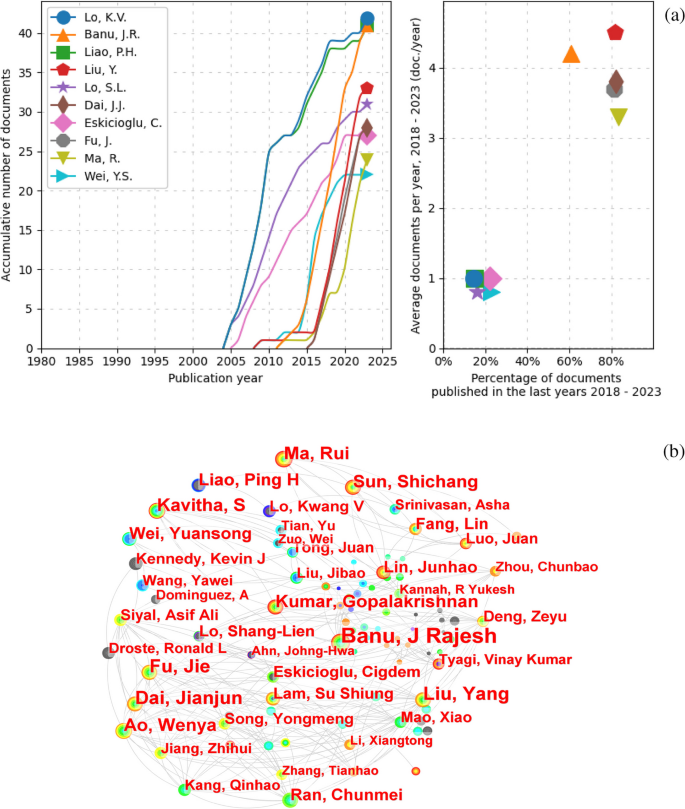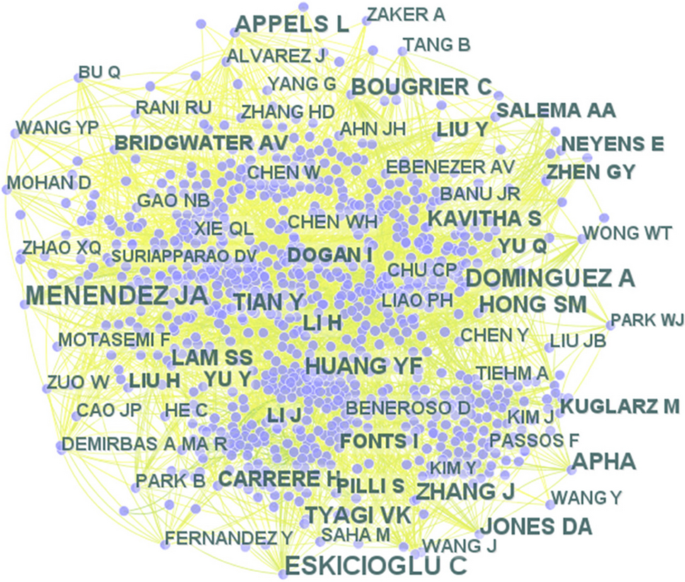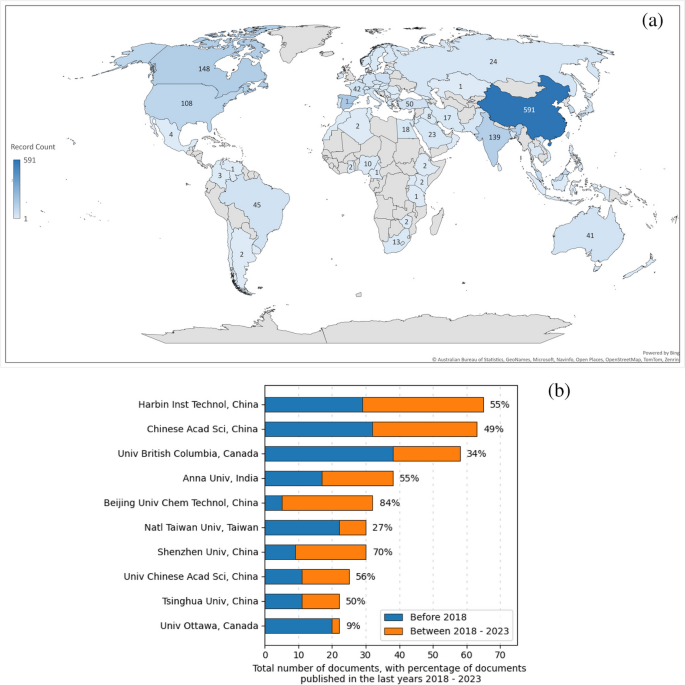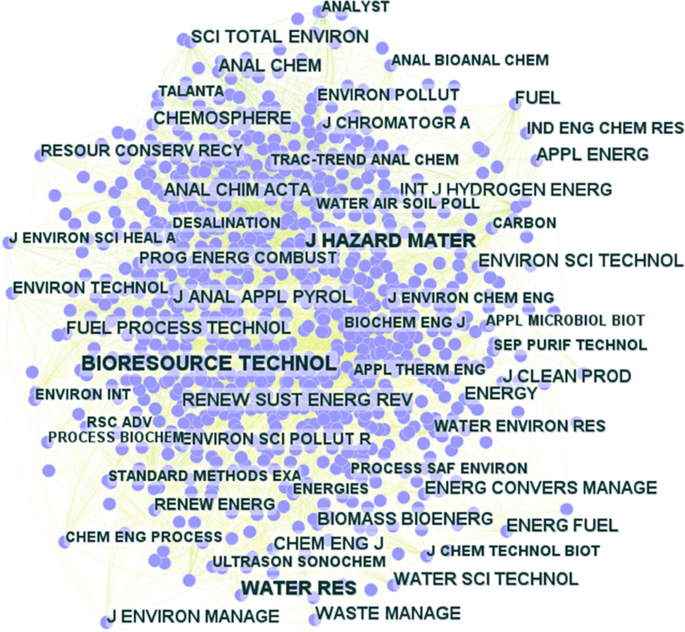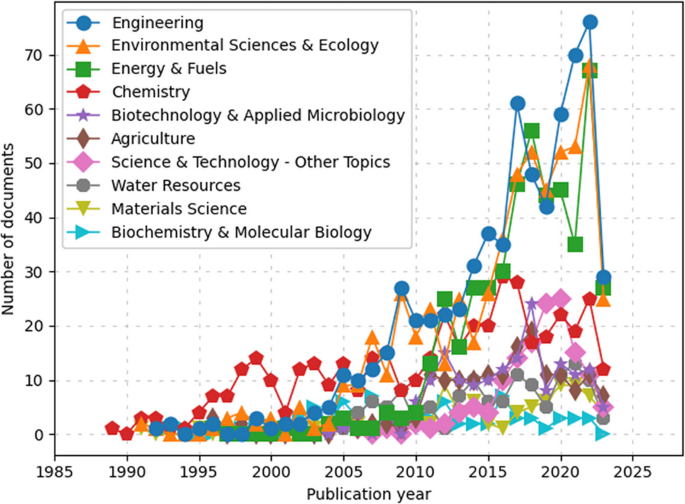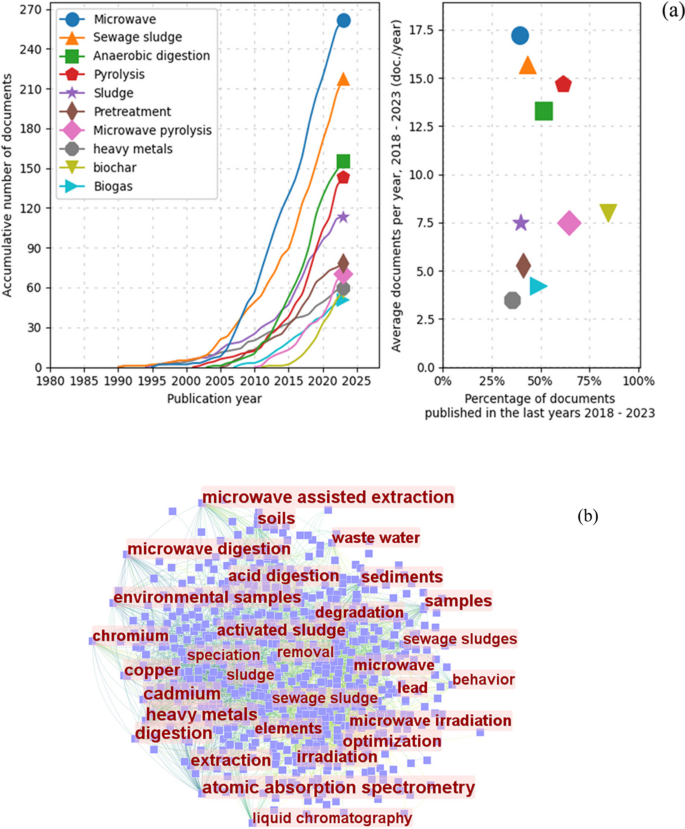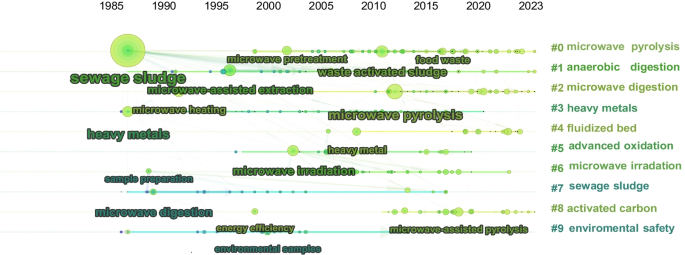Abstract
This manuscript presents a scientometric review of recent advances in microwave pretreatment processes for sewage sludge, systematically identifying existing gaps and prospects. For this purpose, 1763 papers on the application of microwave technology to sludge pretreatment were retrieved from the Web of Science (WoS) using relevant keywords. These publications were then analyzed using diverse scientometric indices. The results show that research in this field encompasses applications based on the non-thermal effects of microwaves, enhanced effectiveness of anaerobic digestion (AD), and the energy balance of this pretreatment system. Overcoming existing technical challenges, such as the cleavage of extracellular polymers, reducing microwave energy consumption, understanding the non-thermal effects of microwaves, promoting AD of sludge in combination with other chemical and physical methods, and expanding the application of the technology, are the main scientific focuses. Additionally, this paper thoroughly examines both the constraints and potential of microwave pretreatment technology for wastewater treatment.
Similar content being viewed by others
Avoid common mistakes on your manuscript.
Introduction
In treating domestic wastewater using the activated sludge method, approximately 7–10 kg of bioactive sludge, mixing of secondary sludge and waste activated sludge (WAS), is generated as a by-product for every 3 m3 of treated wastewater (Bozkurt and Apul 2020). Due to rapid urbanization and population growth, residual sludge production is increasing in many countries. For instance, the annual production of sewage sludge in 15 EU countries increased by almost 50%, from 6.5 million tonnes of dry solids in 1992 to 9.8 million tonnes in 2005 (Kelessidis and Stasinakis 2012). In the US, around 6 million tonnes of dried residual sludge have been generated each year since 2015, with expectations of continued growth (Zhen et al. 2017). China produced 6.25 million tonnes of dry solids in 2013, with projections to reach 39.78 million tonnes by 2020 (Lishan et al. 2018). Anaerobic digestion is a prevalent method for stabilizing sludge, where organic components are transformed into methane through biological processes in an oxygen-deprived environment. However, even with prolonged retention periods (specifically, between 10 and 40 days), a significant portion of organic material (Tyagi and Lo 2011), around 35–45%, exits anaerobic digesters without undergoing digestion (Yuan and Zhu 2016). This issue primarily stems from the properties of WAS, which is a blend containing microbial cells, synthetic and natural organic materials, minerals, and heavy metals, all bound within a polymeric structure of extracellular polymeric substances (EPS) and cations (Gil et al. 2018). The EPS envelops the flocs, while robust cell walls protect the intracellular organic content during AD processing, leading to a deceleration in the hydrolysis stage and resulting in inadequate substrate utilization (Gil et al. 2019).
Before subjecting WAS to anaerobic digestion, hydrolysis can be expedited through various pretreatment approaches such as mechanical (Serrano et al. 2016), chemical (Bougrier et al. 2006; Chu et al. 2009), biological (Barjenbruch and Kopplow 2003; Carvajal et al. 2013), thermal (Eskicioglu et al. 2006; Kuglarz et al. 2013), or a combination of these methods (Toreci et al. 2009; Yu et al. 2010). Among these preparatory techniques, microwave irradiation stands out as an energy-efficient and targeted heating method that can swiftly induce hydrolysis, making it a feasible choice (Tyagi and Lo 2013). Microwave pretreatment, a derivative of traditional thermal pretreatment (Climent et al. 2007) is an emerging technology that has been developed as researchers have studied the biological effects of microwave radiation in depth (Banik et al. 2003). Despite the comprehensive understanding of microwave sludge pretreatment technology in recent years, there are still a number of issues that need to be addressed in its current development.
Numerous studies in the existing literature have documented the positive effects of using microwave pretreatment technology on sewage sludge. Recently, bibliometric analyses (Davarazar et al. 2020) have gained prominence as a method for monitoring and assessing research progress, as well as the contributions of researchers, countries, academic institutions, and global universities in specific domains (Gandia et al. 2019; Hoang et al. 2021). The significance of these crucial and decisive investigations is underscored by the notable increase in the quantity of scientometric research conducted across various scientific disciplines (Olawumi and Chan 2018; Saranya et al. 2018). This paper presents a comprehensive assessment of microwave pretreatment technology for sewage sludge. It conducts a critical review of scientometrics and summarizes all published articles from 1980 to 2023 on the microwave pretreatment of sewage sludge. Additionally, it offers an overview of the technology’s history and current developments in terms of time, region, and research area and highlights both its shortcomings and development prospects in sewage sludge treatment.
Methodology
This section details the scientometric analysis methods and specific literature screening tools utilized in this thesis, encompassing both scientometric and content analysis. The first part delineates the process of using keywords to search the literature in the Web of Science (WoS) core collection database, including how to filter out less relevant literature records by combining different keywords. The second section elucidates the logic behind the search strategy employed in this paper, critically discussing all the literature obtained in the field using three distinct bibliometric tools: CiteSpace, Scientopy, and WoS analysis.
Scientometric analysis
Scientometrics, a branch of informatics, involves the quantitative analysis of scientific literature to discern patterns, emerging trends, and the overall knowledge framework within research domains (Azam et al. 2021). Scientific mapping tools typically process scientific publications as input, producing interactive visual representations of complex structures for statistical examination and visual exploration (Yigitcanlar et al. 2020). A variety of scientific mapping tools are available for quantitative analysis, including HistCite (Garfield 2009), VOSviewer (Sgambati and Gargiulo 2022), Scientopy (Ruiz-Rosero et al. 2019), and CiteSpace (Chen et al. 2012). These tools share a common feature: they all generate scientific maps that depict relationships between various elements, offering a spatial representation of how disciplines, fields, participants (authors, institutions, and countries), and individual papers interconnect (Wagner et al. 2011). In this paper, two such scientific mapping software, Scientopy and CiteSpace, are employed to analyze the application of microwave pretreatment to sewage sludge, ensuring a clear and accurate presentation of the results.
The literature on microwave pretreatment of sewage sludge was sourced from the Web of Science (WoS) core collection database using carefully chosen keywords based on a primary literature survey (Table 1). The advanced search function in WoS centered on keywords related to wastewater treatment (Table 1), and the results from each keyword set were combined using the AND operator to pinpoint relevant literature within the field (Table 1). On May 23, 2023, a compilation of English language papers published between 1981 and 2023 was generated based on this search query. The focus was primarily on identifying papers that included the specified keywords in their titles. A meticulous selection process was employed to ensure precision in the analysis, discarding any irrelevant literature. The relevant records were then tagged within the WoS platform and exported in both ‘tab’ and ‘plain text’ formats for further examination using Scientopy and CiteSpace, respectively. This review included an evaluation of the following metrics: publication year, publication type, contributing country, keywords, authors, cited authors, cited journals, and subject area.
The table includes an asterisk to indicate the inclusion of additional potential keywords, aiming to expand the search scope and reduce the likelihood of missing any pertinent keywords denoted by various letters.
Content analysis
A comprehensive exploration of the published papers necessitates an in-depth scientometric examination. This endeavour aims to unveil past and present research trends concerning microwave pretreatment in sewage sludge treatment. The scientometric tools ‘Web of Science,’ ‘Scientopy,’ and ‘CiteSpace’ serve as foundational resources to facilitate insightful discourse on prevailing and forthcoming research focal points, as well as existing gaps that await resolution through future investigations. The research design of this paper is visually depicted in Fig. 1. Utilizing three distinct bibliometric analyses, this study will scrutinize the entire assemblage of literature records in this domain, dissecting aspects such as publication year, authors, countries, research domains, and keywords. Based on these findings, the paper will identify prevailing deficiencies and chart potential pathways for the evolution of microwave pretreatment technology in sewage sludge treatment.
Results and discussion
The results obtained are discussed and analyzed in this section in three parts. The analysis of the documents includes a categorization of the obtained documentary records in terms of chronological order and document type. Changes in research focus and format over time are summarized, and a conclusion of the highly cited literature in the field is presented to reveal hotspots in microwave pretreatment of sewage sludge. Regarding contributions, the paper discusses the input made to the field by authors, national and research institutions, and journals, respectively. The results of various levels of contribution to the research in this field are visualized using various scientometric tools. Finally, by analyzing trends in different research areas and keywords over time, two major challenges are identified: the mechanism of microwave non-thermal effects and the high energy consumption.
Analysis of documents
Figure 2a illustrates the annual number of publications on the application of microwave pretreatment of sewage sludge. The publications in this field arranged chronologically can be divided into three stages. The first stage marks the inception of microwave pretreatment technology (Stage 1), with the earliest publication dating back to 1981 by Atsuya and Akatsuka (1981). In this article, microwave technology was employed to enhance the accuracy of trace element determination in sludge, using microwave pretreatment to expedite the digestion time of sewage sludge and achieving 92–101% recovery for arsenic determination. Colombini et al. (1998) conducted a study where sludge samples underwent digestion in a microwave oven using an alkaline persulfate solution, followed by analysis for total phosphorus and nitrogen via ion chromatography without preliminary sample treatment. The results demonstrated notable reproducibility and accuracy within the standard concentration range used for wastewater assessment. While not specifically using microwave technology as a pretreatment to enhance anaerobic digestion results, the application of microwave treatment to improve sludge solubility and reduce digestion time has been widely utilized (Pérez-Cid et al. 1999; Santos et al. 2000).
Since 2000 (Stage 2), researchers have increasingly focused on microwave technology as a pretreatment prior to anaerobic digestion (AD), comparing it with other sludge pretreatment technologies. Hong et al. (2004) investigated the effect of microwave radiation versus external heating on pathogen destruction in sewage sludge. They found that cell membranes are damaged with increasing intensity and temperature of microwave radiation, and at the same temperature, microwave radiation more effectively reduces cell activity than external heating, almost ceasing bacterial activity at temperatures above 68 °C. A similar study by Pino-Jelcic et al. (2006) concluded that microwave/digested sludge showed fewer faecal coliforms and Salmonella spp. compared to conventional addition, noting that microwave heating enhanced biodegradability under thermophilic AD and improved the dewatering rate of digested sludge. Eskicioglu et al. (2007b) investigated various sludge concentrations under microwave irradiation at low temperatures (50–96 °C), focusing on the dissolution of activated sludge and cumulative biogas generation through anaerobic digestion. Their findings indicated a significant increase in soluble total chemical oxygen demand (SCOD/TCOD) for high and low sludge concentrations, alongside improved dewatering efficiency of microwave-treated sludge after anaerobic digestion. Zheng et al. (2009) demonstrated that microwave pretreatment at 90 °C for primary sludge with a total solids concentration of 4% led to a 37% increase in the biogas production rate compared to non-pretreated sludge, with their model indicating an increase in biogas yield factor as microwave pretreatment temperature increased.
After 2010 (Stage 3), the publication of papers on microwave pretreatment, particularly for AD and sludge dewatering, increased rapidly. Researchers focused on enhancing microwave energy efficiency and the factors influencing microwave pretreatment. Jackowiak et al. (2011) aimed to optimize microwave pretreatment of wheat straw, with findings indicating a 28% increase in methane yield at 150 °C compared to untreated samples. They also highlighted the need for a positive energy balance, suggesting that microwave equipment power consumption should not exceed 2.65 kJ/g tVS. Uma Rani et al. (2013) found that microwave irradiation reduced the initial lag time of AD, with the best energy-efficient pretreatment lasting 12 min at 70% intensity. Studies also explored microwave pretreatment’s role in different substrates. For instance, Passos et al. (2014) reported a 30% increase in methane production from microalgal biomass, and Tyagi et al. (2014) documented a significant enhancement in sludge from pulp and paper mills following alkali-enhanced microwave pretreatment. Srinivasan et al. (2016) demonstrated high treatment efficiency and low energy requirements in a dairy manure treatment system using microwave and hydrogen peroxide pretreatment. In terms of main influencing factors, Tas et al. (2018) noted microwave pretreatment’s advantages over ultrasonic in methane yield improvement, highlighting economic considerations and the need for large-scale experiment data. Alizadeh et al. (2018) used a mathematical model to fit methane yield and solubilization efficiency, showing that microwave pretreatment enhances AD of kitchen waste by destroying its recalcitrant structure, thereby increasing biogas production, with irradiation time and temperature as key factors.
It is noteworthy that the accumulation of publications within this scientific domain follows a Sigmoidal growth trajectory, as clearly depicted in Fig. 2b, with a high coefficient of determination (R2 = 0.9987). This pattern suggests that the field has yet to reach a definitive stage of maturity, indicating that ongoing research is still actively seeking to fill the existing gaps in knowledge regarding microwave pretreatment for wastewater treatment.
Figure 3 provides a detailed overview of the categories of publications related to the use of microwaves in water and wastewater treatment. It is apparent that research articles are the most common type, accounting for 83.7% of publications, followed by reviews (11.2%), conference abstracts (2.9%), book chapters (1.2%), and other relevant documents such as patents and technical notes. Table 2 summarizes the key conclusions and findings derived from the analyzed papers.
Table 2 summarizes key findings from numerous studies on microwave pretreatment in sewage sludge treatment, encompassing aspects such as effects on sludge decomposition, pathogen destruction, methane production, dewatering performance, and nutrient recovery. The table reveals that microwave pretreatment can enhance methane recovery, improve dewatering, and inactivate pathogens, although the non-thermal effect of microwave and the mechanism remain a subject of controversy. Comparative analysis of microwave pretreatment’s efficiency with methods like ultrasonic pretreatment underscores significant energy and cost considerations.
Given these findings, it is apparent that microwave pretreatment offers considerable potential for sewage sludge treatment, outperforming traditional methods in several respects. Nevertheless, the associated high energy requirements and operational costs pose substantial challenges. The ongoing debate concerning the non-thermal effects and mechanisms of microwaves highlights an urgent need for further research, especially in the context of scaling these effects for industrial-scale applications. Future studies should aim to integrate microwave pretreatment with other emerging technologies to boost its efficiency and feasibility. Additionally, a thorough exploration of the economic and environmental implications of adopting this technology on a larger scale is essential for its practical application and to ensure alignment with sustainability objectives.
Scientometric analysis of authors, countries, and journal contributions
In this section, a comprehensive analysis of various publications related to the use of microwave pretreatment in sewage sludge treatment is presented. This analysis includes an examination of the authors, countries of origin, affiliated organisations, and sources of the publications. Analyzing these elements can reveal insights into evolving trends and the formation of international partnerships in the development of microwave pretreatment research technology globally (Guiling et al. 2022). Furthermore, it provides data to support further quantitative analysis (Rosokhata et al. 2021) for a general overview of the field’s development.
Contribution of authors
Figure 4 illustrates the frequency of publications on microwave pretreatment of sewage sludge. The CiteSpace and Scientopy results (shown in Fig. 4a, b, respectively) identify major contributors in the field such as Lo, K.V. (Lo et al. 2015) and Liao, P.H. (Lo et al. 2018) from Canada, with 42 papers; Banu, JR (Ebenezer et al. 2015) from India, with 41 papers; Liu, Y. (Yang et al. 2013) with 33 papers; and Lo, S.L (Tyagi and Lo 2013) from China, with 31 papers. Figure 4a (left) highlights the papers published in the last five years, indicating these significant contributors have remained active (Ruiz-Rosero et al. 2019). Additionally, there are several authors who have published multiple articles recently. For instance, Dai et al. (Zhang et al. 2017) studied microwave pyrolysis of textile printing and dyeing sludge, Fu et al. (Ao et al. 2018) reviewed the efficiency of activated carbon preparation under microwave radiation, Ma et al. (Ma et al. 2017) explored the impact of catalysts at varying temperatures on the conversion of organic matter and biofuel production by microwave pyrolysis of sludge, and Wei et al. (Niu et al. 2019) investigated microwave pretreatment combined with zero-valent iron technology to enhance AD. This demonstrates the popularity and growth of microwave pretreatment of sludge as a research area.
a The roles and contributions of authors in scientific publications concerning microwave pretreatment of wastewater sludge, as gathered through Scientopy. b CiteSpace outcomes reveal collaborative efforts among diverse authors in this field. The font size corresponds to the extent of an author’s contribution, with larger fonts indicating greater involvement
Apart from the volume of publications, the number of citations an author receives is another metric reflecting their influence on advancing scientific knowledge within the field (Zhang et al. 2022). As depicted in Fig. 5, Cigdem Eskicioglu and collaborators (Kor-Bicakci et al. 2020) are the most cited researchers in this field. While extensive research on microwave pretreatment has been conducted, its application remains predominantly at the laboratory scale. Greater adoption will necessitate further pilot investigations to address existing challenges. For example, Appels et al. (2013) examined the effects of microwave pretreatment using a pilot-scale semi-continuous digester set-up, finding a 50% higher average biogas yield compared to a blank test, though they also highlighted considerations of energy efficiency. Thompson et al. (2019) demonstrated that microwave pretreatment improved the efficiency of saccharification and fermentation using brown algae but noted the need for substantial capital investment and energy input, with plans for future pilot-scale studies. Atelge et al. (2020) also emphasized that while microwave radiation is still in the developmental stage and applied at batch or pilot scale, transitioning to full scale requires transforming the technology from research to a mature technology.
The comprehensive analysis of contributions in the field of microwave pretreatment of sewage sludge underscores a significant trend towards innovative and efficient waste management techniques. While the prolific output of key researchers such as Lo K.V., Banu JR, and Liu Y. demonstrates a robust academic interest, the prevailing focus on laboratory-scale studies signals a gap in the translation of this research into practical, large-scale applications. The high citation rates of works by Cigdem Eskicioglu and others reflect the academic community’s recognition of their valuable insights, yet the field appears to be at a critical juncture. The transition from laboratory to pilot-scale studies, as explored by Appels et al. and Thompson et al., is a crucial step that demands not only scientific rigor but also considerations of economic feasibility and energy efficiency. The future of microwave pretreatment in sewage sludge management hinges on bridging these gaps, transforming research into mature technology capable of addressing real-world environmental challenges. This necessitates a multidisciplinary approach, combining scientific innovation with practical engineering solutions, policy support, and sustainable economic models to realize the full potential of this technology in contributing to environmental sustainability.
Contribution of countries and research organizations
Figure 6 illustrates the delineation of contributions from various countries and organizations to the domain of microwave pretreatment in sewage sludge treatment. According to Fig. 6a, China (591 records), Spain (175 records), and Canada (148 records) have published the highest number of papers in this field. In addition, the scientific output of leading national organizations, as shown in Fig. 6b, has increased significantly since 2018, and new national organisations have started to gradually join the research in this field in recent years. For example, the Harbin Institute of Technology (China) and the Chinese Academy of Sciences (China) have published 55% and 49% of the scientific literature related to microwave pretreatment of sludge in the last five years, respectively. Anna University (India) has also made a significant contribution in the field of microwave pretreatment of sewage sludge in the last 5 years, with 55% of the published literature. Furthermore, according to the information provided in Fig. 6, Chinese and Indian research and development organizations are currently the main players in this research area. Also, through publications in recent years, it can be understood that the main research topics of these organizations are currently focused on the use of different catalysts to synergistically increase the heating rate of microwaves (Li et al. 2022b; Xie et al. 2022; Lu et al. 2023), the use of microwave-assisted technology to enhance the energy conversion rate of bio-waste (Yang et al. 2022; Chandrasekaran and Chithra 2022; Usmani et al. 2023), and microwave pretreatment technology to enhance hydrogen production from sludge (Dinesh Kumar et al. 2020; Zhao et al. 2023). This bodes well for the future development of sludge pretreatment in favor of industrialization and energy efficiency.
In terms of publication sources, an analysis via WoS indicates that ‘Bioresource Technology,’ ‘Water Research,’ and ‘Journal of Hazardous Materials’ are the leading journals in this area, with 248, 241, and 242 papers, respectively. Figure 7 visually represents the contributions of scientific journals to the research landscape in microwave pretreatment technology. However, it is important to note that the correlation between the number of published papers and citations received is not always direct. In some cases, journals may publish fewer papers but receive a considerable number of citations. For example, ‘Environmental Science and Technology’ has published 131 papers on microwave pretreatment, yet it holds the highest average citations per article (101.79) among all journals in this field.
The international landscape of microwave pretreatment research, dominated by Chinese and Indian organizations, underscores the global recognition of the importance of sustainable waste management. The significant involvement of countries and organizations in advancing this technology highlights a collaborative effort towards environmental sustainability. The focus on innovative research topics like catalyst use for increased heating rates, energy conversion enhancement, and hydrogen production from sludge reflects a progressive approach towards addressing energy and environmental challenges. This trend towards specialisation in microwave pretreatment indicates a promising future for this technology, potentially leading to industrial-scale applications. However, the successful transition from laboratory research to industrial application will require a concerted effort in overcoming technical, economic, and regulatory challenges. This necessitates not only continuous scientific innovation but also the need for international collaboration, policy development, and investment in pilot projects to facilitate the practical implementation of these research findings. The integration of these diverse elements will be crucial in realizing the full potential of microwave pretreatment technology in contributing to a sustainable future.
Trends in microwave pretreatment technology
Keyword and subject area analysis reveals that microwave pretreatment is a major trend in sewage sludge applications (Macías-Quiroga et al. 2021). Figure 8 illustrates the diverse nature of research in this domain, covering a range of disciplines, including engineering, environmental science, energy, chemistry, biotechnology, agriculture, water resources, and, to a lesser extent, materials science and biochemistry.
Figure 9a identifies key keywords in papers on microwave pretreatment of sewage sludge, highlighting hot topics such as enhancing anaerobic digestion (AD), microwave pyrolysis mechanisms, combined catalyst use, and biogas production. These topics are consistent with previous findings on national and research institute contributions, indicating a coherent research trend (refer to “Contribution of countries and research organizations”). The keyword search results using CiteSpace (Fig. 9b) offer an intuitive insight into current hotspots in microwave pretreatment research (López-Serrano et al. 2020). In addition to the previously mentioned topics, new keywords like optimization, degradation, and behavior have emerged. These are related to research on improving biogas purity through microwave pretreatment (Wang et al. 2022; Luo et al. 2023), enhancing sludge hydrolysis post-microwaving (Cheng et al. 2023), and the destruction of cellulose in sludge (Kazawadi et al. 2022).
The timeline visualization is designed to illustrate the evolution of key trends in the research domain. It includes aspects such as the emergence of keywords within clusters, the timing of their introduction, the changing significance of clusters over time, and the identification of symbolic keywords, particularly those with high and medium centrality (Zhang et al. 2023). This visualization aids in comprehending the developmental trajectory and current focus areas within the field.
In the context of keyword analysis focused on microwave-pre-treated sludge, Fig. 10 illustrates the development of the initial 10 clusters. Among these, clusters such as (#0) microwave pyrolysis, (#1) anaerobic digestion, and (#2) microwave digestion have consistently garnered significant attention since their introduction in this field. Emerging themes like microwave co-pretreatment, sludge drying, and the immobilization of heavy metals in sludge have evolved from earlier clusters. Notably, from 1981 until approximately 2014, sewage sludge was the primary focus of microwave pretreatment research, with a gradual shift towards exploring reaction mechanisms and optimising effects in more recent years. Table 3 summarizes the latest advancements in microwave pretreatment for sludge.
The keyword and subject area analysis of microwave pretreatment research reveals a multidisciplinary convergence, highlighting the field’s complexity and its far-reaching implications. The evolution from a focus on sewage sludge to exploring various reaction mechanisms and optimization techniques indicates a maturing research area. As new keywords like ‘optimisation,’ ‘degradation,’ and ‘behavior’ emerge, they reflect the shifting focus towards enhancing operational efficiencies and understanding deeper scientific processes. However, as the field advances, it faces the challenge of integrating these diverse scientific insights into practical, scalable solutions. This integration requires a balance between innovative research and the pragmatic challenges of implementation, including economic viability and environmental impact. The future direction of this research, therefore, hinges on a synergistic approach that combines scientific discovery with real-world applicability, ensuring that the benefits of microwave pretreatment extend beyond theoretical research to tangible environmental and societal impacts.
Microwave non-thermal effects
Microwaves can interact with flocculants in sludge, releasing bound organic matter into solution and breaking down extracellular polymers (Kuglarz et al. 2013). They shield the cell wall within the microflocculant assembly and release intracellular organic matter through three pathways: thermal (Tang et al. 2010), non-thermal (ESKICIOGLU et al. 2007b), and catalytic oxidation (Quan et al. 2007). Thermal effects include solubilization of organic matter, such as denaturing membrane proteins and releasing intracellular organelles, and exceeding the boiling point of intracellular fluids, potentially leading to cell wall rupture (Atkinson et al. 2019). High temperatures can reduce the solubility of gases, forming gas domains (bubbles) in the slurry that may exert additional pressure on cell walls upon bursting. Conversely, high temperatures (70–180 °C) can lead to the polymerisation of low molecular weight sugars and amino acids through the Maillard reaction, resulting in the formation of recalcitrant polymeric organic compounds, potentially reducing the anaerobic digestibility of the resultant product (Eskicioglu et al. 2007a; Toreci et al. 2011).
Non-thermal effects, such as specific effects of electromagnetic radiation, are caused by the rapid oscillation of polar and polarizable molecules or polarized side chains of macromolecules attempting to align with incident electromagnetic waves (Yeneneh et al. 2015). Microwave energy converts to heat through internal rotational resistance, potentially leading to bond breakdown and reorientation. Despite postulations in the literature about non-thermal microwave decomposition pathways, conclusive evidence remains scarce. Experimentally isolating non-thermal effects is challenging, as conventional heating principles differ from microwave radiation, and internal molecular-level temperature monitoring is not straightforward (Kostas et al. 2017). Rao et al. (2022) explored microwave non-thermal effects by examining sludge cake pore structures and analyzing fractal dimensions, suggesting improvements in sludge dewatering were due to non-thermal effects on drainage pore structure and moisture distribution. Conversely, Park and Ahn (2011) and Dai et al. (2013) found no substantial non-thermal effects when comparing microwave pyrolysis with conventional heating in terms of biogas yield, SCOD/TCOD ratios, and emissions of PCDD/Fs. Sólyom et al. (2011) also observed similar biogas production results with both heating methods, indicating a lack of non-thermal microwave effects. Therefore, using microwave pretreatment alongside conventional heating methods to validate the existence of non-thermal effects might not be reliable. More conclusive evidence could potentially be obtained through microstructural observations of sludge or a combination of simulation and experimentation.
Energy consumption
Microwave pretreatment of sewage sludge, especially at the laboratory scale, demonstrates significant potential for enhancing biogas production when integrated with anaerobic digesters. This enhancement is attributed to both the thermal (Ahn et al. 2009) and non-thermal (Tyagi and Lo 2013) effects of microwave processing that disrupt the complex floc structure of the sludge. This disruption unfolds and denatures complex organic molecules, including intracellular and extracellular components, making them smaller and more biodegradable (Li et al. 2022a). Such a process results in a notable increase in SCOD, a critical factor in boosting biogas production during subsequent anaerobic digestion. Research (Yu et al. 2010) has shown that microwave irradiation (total irradiation energy of 630 kJ) can raise the SCOD/TCOD ratio in sludge from 2 to 22%. Similarly, in WAS, this ratio increased from 8 to 18% after microwave heating at 72.5 °C and from 6 to 18% following treatment at 96 °C. Gil et al. (2019) reported an increase in solubility (COD/TVS ratio) of floating sewage sludge ranging from 43 to 66%, depending on the total energy applied and the power rating.
In addition to the increase in SCOD content, microwave irradiation significantly enhances biogas production from sludge (Yu et al. 2010). Subjecting WAS to microwave treatment at various temperatures results in a notable increase in both the rate and volume of biogas generated. The kinetic equation for biogas production from microwave-pretreated sludge is given in Eqs. 1–3 (Ebenezer et al. 2015; Ude and Oluka 2022), where S represents SCOD, B is the biogas yield, R is the reaction rate, k is the rate constant Qi is the input flow rate, Q0 is the output flow rate, while Si and S0 are the influent SCOD and effluent SCOD, respectively, and Vd is the digester volume. The improvement in biogas production can be attributed to the increased SCOD, as indicated by these equations.
However, despite the benefits, energy consumption is crucial for scaling up microwave pretreatment technology for industrial application (Cano et al. 2015). Table 4 highlights the challenge of achieving a favourable energy balance, which is essential for the practical application of this technology on an industrial scale. Therefore, while microwave pretreatment offers significant potential in enhancing biogas production, optimizing the process to reduce energy consumption while maintaining high biogas yields is vital for its large-scale viability.
To enhance the energy viability of microwave pretreatment technology, significant research efforts have been made recently. Balasundaram et al. (2022) observed that low-temperature pretreatment (< 100 °C) reduces electrical energy consumption and achieves a positive energy balance, but the increased electrical demand from microwaves challenges the system’s energy self-sufficiency. Tang et al. (2010) highlighted that moisture content significantly affects microwave irradiation energy efficiency, and reducing sludge moisture content can decrease microwave energy input. Kavitha et al. (2018) implemented ultrasonic-assisted microwave pretreatment to increase methane yield, resulting in a net profit of US $2.67 per ton, although this study did not consider plant investment costs. Other studies, such as those by Kang et al. (2020), have utilized carbon nanotube-coated microwave vessels to enhance energy efficiency and sludge dissolution, showing promising results at the laboratory scale but lacking data from pilot and industrial-scale experiments. In conclusion, energy consumption remains a major barrier to the widespread adoption of microwave pretreatment, with the ongoing challenge being to reduce energy costs while increasing biogas production.
Limitations and prospects
The effectiveness of microwave pretreatment in anaerobic sludge digestion, sludge dewatering, and increased biogas production has been established in multiple studies. Whether applied alone or in combination with chemical, physical, and other auxiliary methods, microwave pretreatment has shown great promise as a method for sludge pretreatment. Numerous laboratory-scale experiments provide ample evidence to support the application of this technology in larger-scale experimental studies.
Despite the maturity of microwave pretreatment for sludge effluent technology, the mechanistic study of microwave radiation remains controversial. The existence of microwave non-thermal effects and the modeling of microwave mechanisms for industrial-scale applications continue to be important directions for future development. While there have been some studies on the modeling of microwave heating, these predominantly focus on food (Campañone et al. 2012; Yang and Chen 2021), materials (Lovás et al. 2010; Goyal and Vlachos 2020), and chemistry (Zhang et al. 2000; Zhu et al. 2007). However, there remains a gap in the modeling of microwave treatment of sewage sludge. The integration of microwave heating with sludge structural analysis could significantly bolster the expansion of microwave pretreatment in industrial applications.
Industrial applications are another key factor limiting the wider use of microwave pretreatment. Most research in this area has focused on laboratory-scale (Zaker et al. 2019; Bozkurt and Apul 2020; Vialkova et al. 2021), although there have been pilot-scale (Kocbek et al. 2020; Guo et al. 2021) experiments confirming the potential successful application of microwave pretreatment technology. However, progress from laboratory to pilot scale has been hindered by apparent inconsistencies in performance in the original experiments. These inconsistencies can be attributed to factors such as variability in sludge characteristics and differences in microwave treatment parameters. For instance, Mawioo et al. (2017) used four diverse types of sludge (partially dewatered/centrifuged WAS, fresh faecal sludge, septic tank sludge, and WAS) to examine the performance of a microwave reactor at pilot scale. The results showed that microwave-based technology is a promising option for the treatment of faecal sludge, septic sludge, and WAS; however, due to differing organic contents, sanitization and volume reduction performances showed significant differences. Passos et al. (2015) compared thermal (95 °C, 10 h) and microwave irradiation (900 W, 3 min, 34.3 MJ/kg TS) for improving microalgae anaerobic digestion at pilot scale, finding that the best results were obtained with thermal pretreatment (95 °C, 10 h) rather than microwave irradiation, likely due to the choice of microwave treatment parameters.
Additionally, complexities in scaling up, such as managing uniform heating and precise parameter control in larger setups, equipment limitations for processing large volumes, and the economic challenges associated with larger-scale operations, contribute to these inconsistencies. Aguilar-Reynosa et al. (2017) point out that for the development of microwave reactors, it is necessary to further explore the design of applicators (traveling wave, multimode, and monomodal cavities) that enable high-power densities and faster heating rates, thereby assessing microwave heating processing as an alternative pretreatment in second-generation biorefineries.
Building upon these challenges, microwave pretreatment faces its own set of hurdles that need addressing to enable industrialization. Key among these is a more thorough understanding of the interactions and relationships between microwave radiation, biomass, and the heating medium, particularly concerning the non-thermal effects of microwave irradiation on biomass; the development of more efficient microwave absorbents that can effectively transfer energy to the biomass and be easily separated afterwards; and the upscaling of microwave pretreatment reactors to accommodate large-scale treatment of various types of sewage sludge.
Conclusions
In conclusion, this scientometric analysis of 1763 bibliographic records provides a comprehensive overview of the development and current state of microwave pretreatment technology in sewage sludge treatment. The study traces the technology’s evolution, highlights significant advancements, identifies challenges, and suggests potential future directions. The global contributions and thematic focuses reflect the technology’s dynamic role in environmental management practices. The primary conclusions of this research are summarized as follows:
-
Originating in the 1980s for trace substance measurement in sludge, microwave pretreatment technology has evolved significantly, becoming a key strategy for optimizing anaerobic digestion processes.
-
Since 2010, there has been a notable shift in focus towards the mechanics of microwave pretreatment, aimed at enhancing energy efficiency and refining treatment techniques, indicating a progression to more advanced methodologies.
-
Contributions from key figures like Cigdem Eskicioglu and research teams in China, India, and the USA highlight global interest. Research themes have centred around “microwave pyrolysis,” “anaerobic digestion,” “biogas,” and “degradation.”
-
The study underscores a consistent emphasis on enhancing energy efficiency and exploring combinations with other treatment methods, signaling a mature phase in the development of microwave pretreatment methods.
-
The transition from laboratory to industrial scale has faced challenges due to inconsistencies in performance and the need for comprehensive mathematical models for accurately representing microwave radiation mechanisms.
-
A significant gap exists in the development of comprehensive models that capture the interactions between microwave radiation and sludge components, which is crucial for scalability and assessing environmental impact.
-
Industrial-scale application of this technology confronts challenges in developing scalable operational models, evaluating economic viability, and understanding the comprehensive environmental impact.
-
Fostering collaboration between academia and industry is essential for translating laboratory findings into practical, scalable solutions.
-
Addressing the identified research gaps and focusing on practical applications are crucial for the transition of this technology from laboratory research to impactful industrial solutions, ensuring its sustainability and wider adoption.
Data availability
This literature review is based on publicly available sources, including peer-reviewed journal articles, conference papers, books, and online resources. Where possible, references have been directly linked to their source URLs or DOIs to facilitate access.
References
Agrawal AV, Chaudhari PK, Ghosh P (2023) Effect of microwave treatment on maximizing biogas yield for anaerobic co-digestion of fruit and vegetable waste and anaerobic sludge. Biomass Convers Biorefin. https://doi.org/10.1007/s13399-023-04114-y
Aguilar-Reynosa A, Romaní A, Ma. Rodríguez-Jasso R et al (2017) Microwave heating processing as alternative of pretreatment in second-generation biorefinery: an overview. Energy Convers Manag 136:50–65. https://doi.org/10.1016/j.enconman.2017.01.004
Ahn JH, Shin SG, Hwang S (2009) Effect of microwave irradiation on the disintegration and acidogenesis of municipal secondary sludge. Chem Eng J 153:145–150. https://doi.org/10.1016/J.CEJ.2009.06.032
Alizadeh HHA, Seifi R, Radmard SA (2018) Evaluation of the anaerobic digestion of kitchen waste by thermal pretreatment in a batch leach bed reactor with down flow and the kinetics of methane yields. Biofuels 9:315–323. https://doi.org/10.1080/17597269.2016.1266235
Ao W, Fu J, Mao X et al (2018) Microwave assisted preparation of activated carbon from biomass: a review. Renew Sustain Energy Rev 92:958–979. https://doi.org/10.1016/j.rser.2018.04.051
Appels L, Houtmeyers S, Degrève J et al (2013) Influence of microwave pre-treatment on sludge solubilization and pilot scale semi-continuous anaerobic digestion. Bioresour Technol 128:598–603. https://doi.org/10.1016/j.biortech.2012.11.007
Atelge MR, Atabani AE, Banu JR et al (2020) A critical review of pretreatment technologies to enhance anaerobic digestion and energy recovery. Fuel 270:117494. https://doi.org/10.1016/j.fuel.2020.117494
Atkinson AJ, Apul OG, Schneider O et al (2019) Nanobubble technologies offer opportunities to improve water treatment. Acc Chem Res 52:1196–1205. https://doi.org/10.1021/acs.accounts.8b00606
Atsuya I, Akatsuka K (1981) Determination of trace amounts of arsenic using a capacitively coupled microwave plasma combined with hydride generation: applications to sewage sludge, iron and steels. Spectrochim Acta Part B At Spectrosc 36:747–755. https://doi.org/10.1016/0584-8547(81)80126-7
Azam A, Ahmed A, Wang H et al (2021) Knowledge structure and research progress in wind power generation (WPG) from 2005 to 2020 using CiteSpace based scientometric analysis. J Clean Prod 295:126496. https://doi.org/10.1016/j.jclepro.2021.126496
Balasundaram G, Vidyarthi PK, Gahlot P, Arora P, Kumar V, Kumar M, Kazmi AA, Tyagi VK (2022) Energy feasibility and life cycle assessment of sludge pretreatment methods for advanced anaerobic digestion. Bioresour Technol 357:127345. https://doi.org/10.1016/j.biortech.2022.127345
Banik S, Bandyopadhyay S, Ganguly S (2003) Bioeffects of microwave––a brief review. Bioresour Technol 87:155–159. https://doi.org/10.1016/S0960-8524(02)00169-4
Barjenbruch M, Kopplow O (2003) Enzymatic, mechanical and thermal pre-treatment of surplus sludge. Adv Environ Res 7:715–720. https://doi.org/10.1016/S1093-0191(02)00032-1
Bougrier C, Albasi C, Delgenès JP, Carrère H (2006) Effect of ultrasonic, thermal and ozone pre-treatments on waste activated sludge solubilisation and anaerobic biodegradability. Chem Eng Process 45:711–718. https://doi.org/10.1016/j.cep.2006.02.005
Bozkurt YC, Apul OG (2020) Critical review for microwave pretreatment of waste-activated sludge prior to anaerobic digestion. Curr Opin Environ Sci Health 14:1–9. https://doi.org/10.1016/j.coesh.2019.10.003
Campañone LA, Paola CA, Mascheroni RH (2012) Modeling and simulation of microwave heating of foods under different process schedules. Food Bioproc Tech 5:738–749. https://doi.org/10.1007/s11947-010-0378-5
Cano R, Pérez-Elvira SI, Fdz-Polanco F (2015) Energy feasibility study of sludge pretreatments: a review. Appl Energy 149:176–185. https://doi.org/10.1016/j.apenergy.2015.03.132
Carvajal A, Peña M, Pérez-Elvira S (2013) Autohydrolysis pretreatment of secondary sludge for anaerobic digestion. Biochem Eng J 75:21–31. https://doi.org/10.1016/j.bej.2013.03.002
Chandrasekaran M, Chithra K (2022) Optimization studies on bio-oil yield using microwave-assisted pyrolysis of bio-sludge. Biofuels 13:1165–1171. https://doi.org/10.1080/17597269.2022.2113927
Chen C, Hu Z, Liu S, Tseng H (2012) Emerging trends in regenerative medicine: a scientometric analysis in CiteSpace. Expert Opin Biol Ther 12:593–608. https://doi.org/10.1517/14712598.2012.674507
Cheng P, Yang L, Liu Y et al (2023) Promotion of sugar extraction from sewage sludge by microwave combined with thermal-alkaline pretreatment. Water (basel) 15:1291. https://doi.org/10.3390/w15071291
Chu L, Yan S, Xing X-H et al (2009) Progress and perspectives of sludge ozonation as a powerful pretreatment method for minimization of excess sludge production. Water Res 43:1811–1822. https://doi.org/10.1016/j.watres.2009.02.012
Climent M, Ferrer I, del Baeza M, M, et al (2007) Effects of thermal and mechanical pretreatments of secondary sludge on biogas production under thermophilic conditions. Chem Eng J 133:335–342. https://doi.org/10.1016/j.cej.2007.02.020
Colombini S, Polesello S, Valsecchi S (1998) Use of column-switching ion chromatography for the simultaneous determination of total nitrogen and phosphorus after microwave assisted persulphate digestion. J Chromatogr A 822:162–166. https://doi.org/10.1016/S0021-9673(98)00569-X
Dai Q, Jiang X, Wang F et al (2013) PCDD/Fs in wet sewage sludge pyrolysis using conventional and microwave heating. J Anal Appl Pyrolysis 104:280–286. https://doi.org/10.1016/j.jaap.2013.07.005
Davarazar M, Mostafaie A, Jahanianfard D et al (2020) Treatment technologies for pharmaceutical effluents-a scientometric study. J Environ Manage 254:109800. https://doi.org/10.1016/j.jenvman.2019.109800
Dinesh Kumar M, Yukesh Kannah R, Kumar G et al (2020) A novel energetically efficient combinative microwave pretreatment for achieving profitable hydrogen production from marine macro algae (Ulva reticulate). Bioresour Technol 301:122759. https://doi.org/10.1016/j.biortech.2020.122759
Ebenezer AV, Arulazhagan P, Adish Kumar S et al (2015) Effect of deflocculation on the efficiency of low-energy microwave pretreatment and anaerobic biodegradation of waste activated sludge. Appl Energy 145:104–110. https://doi.org/10.1016/j.apenergy.2015.01.133
Eskicioglu C, Kennedy KJ, Droste RL (2006) Characterization of soluble organic matter of waste activated sludge before and after thermal pretreatment. Water Res 40:3725–3736. https://doi.org/10.1016/j.watres.2006.08.017
Eskicioglu C, Droste RL, Kennedy KJ (2007a) Performance of anaerobic waste activated sludge digesters after microwave pretreatment. Water Environ Res 79:2265–2273. https://doi.org/10.2175/106143007X176004
Eskicioglu C, Kennedy KJ, Droste RL (2007b) Enhancement of batch waste activated sludge digestion by microwave pretreatment. Water Environ Res 79:2304–2317. https://doi.org/10.2175/106143007X184069
Gahlot P, Balasundaram G, Tyagi VK et al (2022) Principles and potential of thermal hydrolysis of sewage sludge to enhance anaerobic digestion. Environ Res 214:113856. https://doi.org/10.1016/j.envres.2022.113856
Gandia RM, Antonialli F, Cavazza BH et al (2019) Autonomous vehicles: scientometric and bibliometric review. Transp Rev 39:9–28. https://doi.org/10.1080/01441647.2018.1518937
Garfield E (2009) From the science of science to scientometrics visualizing the history of science with HistCite software. J Informetr 3:173–179. https://doi.org/10.1016/j.joi.2009.03.009
Gil A, Siles JA, Martín MA et al (2018) Effect of microwave pretreatment on semi-continuous anaerobic digestion of sewage sludge. Renew Energy 115:917–925. https://doi.org/10.1016/j.renene.2017.07.112
Gil A, Siles JA, Toledo M, Martín MA (2019) Effect of microwave pretreatment on centrifuged and floated sewage sludge derived from wastewater treatment plants. Process Saf Environ Prot 128:251–258. https://doi.org/10.1016/j.psep.2019.05.053
Goyal H, Vlachos DG (2020) Multiscale modeling of microwave-heated multiphase systems. Chem Eng J 397:125262. https://doi.org/10.1016/j.cej.2020.125262
Guiling Y, Panatik SA, Sukor MSM et al (2022) Bibliometric analysis of global research on organizational citizenship behavior from 2000 to 2019. SAGE Open 12:215824402210798. https://doi.org/10.1177/21582440221079898
Guo J, Zheng L, Li Z (2021) Microwave drying behavior, energy consumption, and mathematical modeling of sewage sludge in a novel pilot-scale microwave drying system. Sci Total Environ 777:146109. https://doi.org/10.1016/j.scitotenv.2021.146109
Hoang AT, Nižetić S, Ong HC et al (2021) Insight into the recent advances of microwave pretreatment technologies for the conversion of lignocellulosic biomass into sustainable biofuel. Chemosphere 281:130878. https://doi.org/10.1016/j.chemosphere.2021.130878
Hong SM, Park JK, Lee YO (2004) Mechanisms of microwave irradiation involved in the destruction of fecal coliforms from biosolids. Water Res 38:1615–1625. https://doi.org/10.1016/j.watres.2003.12.011
Houtmeyers S, Degrève J, Willems K et al (2014) Comparing the influence of low power ultrasonic and microwave pre-treatments on the solubilisation and semi-continuous anaerobic digestion of waste activated sludge. Bioresour Technol 171:44–49. https://doi.org/10.1016/j.biortech.2014.08.029
Jackowiak D, Bassard D, Pauss A, Ribeiro T (2011) Optimisation of a microwave pretreatment of wheat straw for methane production. Bioresour Technol 102:6750–6756. https://doi.org/10.1016/j.biortech.2011.03.107
Kang KH, Kim J, Jeon H, Byun I (2020) Energy efficient sludge solubilization by microwave irradiation under carbon nanotube (CNT)-coated condition. J Environ Manag 259:110089. https://doi.org/10.1016/j.jenvman.2020.110089
Kavitha S, Rajesh Banu J, Vinoth Kumar J, Rajkumar M (2016) Improving the biogas production performance of municipal waste activated sludge via disperser induced microwave disintegration. Bioresour Technol 217:21–27. https://doi.org/10.1016/j.biortech.2016.02.034
Kavitha S, Banu JR, Kumar G, Kaliappan S, Yeom IT (2018) Profitable ultrasonic assisted microwave disintegration of sludge biomass: modelling of biomethanation and energy parameter analysis. Bioresour Technol 254:203–213. https://doi.org/10.1016/j.biortech.2018.01.072
Kazawadi D, Ntalikwa J, Kombe G (2022) Co-pyrolysis of cashew nut, coconut shells, and rice husk waste: kinetic and thermodynamic investigations. Energy Sources A: Recovery Util Environ Eff 44:5896–5915. https://doi.org/10.1080/15567036.2022.2091689
Kelessidis A, Stasinakis AS (2012) Comparative study of the methods used for treatment and final disposal of sewage sludge in European countries. Waste Manage 32:1186–1195. https://doi.org/10.1016/j.wasman.2012.01.012
Kocbek E, Garcia HA, Hooijmans CM et al (2020) Microwave treatment of municipal sewage sludge: evaluation of the drying performance and energy demand of a pilot-scale microwave drying system. Sci Total Environ 742:140541. https://doi.org/10.1016/j.scitotenv.2020.140541
Kor-Bicakci G, Ubay-Cokgor E, Eskicioglu C (2019) Effect of dewatered sludge microwave pretreatment temperature and duration on net energy generation and biosolids quality from anaerobic digestion. Energy 168:782–795. https://doi.org/10.1016/j.energy.2018.11.103
Kor-Bicakci G, Ubay-Cokgor E, Eskicioglu C (2020) Comparative analysis of bacterial and archaeal community structure in microwave pretreated thermophilic and mesophilic anaerobic digesters utilizing mixed sludge under organic overloading. Water 12:887. https://doi.org/10.3390/w12030887
Kostas ET, Beneroso D, Robinson JP (2017) The application of microwave heating in bioenergy: a review on the microwave pre-treatment and upgrading technologies for biomass. Renew Sustain Energy Rev 77:12–27. https://doi.org/10.1016/j.rser.2017.03.135
Kuglarz M, Karakashev D, Angelidaki I (2013) Microwave and thermal pretreatment as methods for increasing the biogas potential of secondary sludge from municipal wastewater treatment plants. Bioresour Technol 134:290–297. https://doi.org/10.1016/j.biortech.2013.02.001
Li H, Xu J, Mbugua Nyambura S et al (2022a) Food waste pyrolysis by traditional heating and microwave heating: a review. Fuel 324:124574. https://doi.org/10.1016/j.fuel.2022.124574
Li M, Yu Z, Bin Y et al (2022b) Microwave-assisted pyrolysis of eucalyptus wood with MoO3 and different nitrogen sources for coproducing nitrogen-rich bio-oil and char. J Anal Appl Pyrolysis 167:105666. https://doi.org/10.1016/j.jaap.2022.105666
Lishan X, Tao L, Yin W et al (2018) Comparative life cycle assessment of sludge management: a case study of Xiamen, China. J Clean Prod 192:354–363. https://doi.org/10.1016/j.jclepro.2018.04.171
Liu J, Wei Y, Li K et al (2016) Microwave-acid pretreatment: a potential process for enhancing sludge dewaterability. Water Res 90:225–234. https://doi.org/10.1016/j.watres.2015.12.012
Lo KV, Srinivasan A, Liao PH, Bailey S (2015) Microwave oxidation treatment of sewage sludge. J Environ Sci Health A 50:882–889. https://doi.org/10.1080/10934529.2015.1019811
Lo KV, Tunile I, Tan H et al (2018) Microwave enhanced advanced oxidation treatment of sewage sludge from the membrane-enhanced biological phosphorus removal process. Sep Purif Technol 197:202–209. https://doi.org/10.1016/j.seppur.2018.01.008
López-Serrano MJ, Velasco-Muñoz JF, Aznar-Sánchez JA, Román-Sánchez IM (2020) Sustainable use of wastewater in agriculture: a bibliometric analysis of worldwide research. Sustainability 12:8948. https://doi.org/10.3390/su12218948
Lovás M, Kováčová M, Dimitrakis G et al (2010) Modeling of microwave heating of andesite and minerals. Int J Heat Mass Transf 53:3387–3393. https://doi.org/10.1016/j.ijheatmasstransfer.2010.03.012
Lu M, Guo R, Feng Q et al (2023) Effect of calcium peroxide assisted microwave irradiation pretreatment on humus formation and microbial community in straw and dairy manure composting. Bioresour Technol 374:128780. https://doi.org/10.1016/j.biortech.2023.128780
Luo J, Ma R, Lin J et al (2023) Review of microwave pyrolysis of sludge to produce high quality biogas: multi-perspectives process optimization and critical issues proposal. Renew Sustain Energy Rev 173:113107. https://doi.org/10.1016/j.rser.2022.113107
Ma R, Huang X, Zhou Y et al (2017) The effects of catalysts on the conversion of organic matter and bio-fuel production in the microwave pyrolysis of sludge at different temperatures. Bioresour Technol 238:616–623. https://doi.org/10.1016/j.biortech.2017.04.103
Macías-Quiroga IF, Henao-Aguirre PA, Marín-Flórez A et al (2021) Bibliometric analysis of advanced oxidation processes (AOPs) in wastewater treatment: global and Ibero-American research trends. Environ Sci Pollut Res 28:23791–23811. https://doi.org/10.1007/s11356-020-11333-7
Mawioo PM, Garcia HA, Hooijmans CM et al (2017) A pilot-scale microwave technology for sludge sanitization and drying. Sci Total Environ 601–602:1437–1448. https://doi.org/10.1016/j.scitotenv.2017.06.004
Niu Y-T, Liu J-B, Ma S et al (2019) Enhancement for anaerobic digestion of waste activated sludge based on microwave pretreatment combined with zero valent iron. Huan Jing Ke Xue 40:1431–1438. https://doi.org/10.13227/j.hjkx.201806079
Olawumi TO, Chan DWM (2018) A scientometric review of global research on sustainability and sustainable development. J Clean Prod 183:231–250. https://doi.org/10.1016/j.jclepro.2018.02.162
Park W-J, Ahn J-H (2011) Effects of microwave pretreatment on mesophilic anaerobic digestion for mixture of primary and secondary sludges compared with thermal pretreatment. Environ Eng Res 16:103–109. https://doi.org/10.4491/eer.2011.16.2.103
Park B, Ahn J-H, Kim J, Hwang S (2004) Use of microwave pretreatment for enhanced anaerobiosis of secondary sludge. Water Sci Technol 50:17–23. https://doi.org/10.2166/wst.2004.0523
Passos F, Solé M, García J, Ferrer I (2013) Biogas production from microalgae grown in wastewater: effect of microwave pretreatment. Appl Energy 108:168–175. https://doi.org/10.1016/j.apenergy.2013.02.042
Passos F, Hernández-Mariné M, García J, Ferrer I (2014) Long-term anaerobic digestion of microalgae grown in HRAP for wastewater treatment. Effect of microwave pretreatment. Water Res 49:351–359. https://doi.org/10.1016/j.watres.2013.10.013
Passos F, Carretero J, Ferrer I (2015) Comparing pretreatment methods for improving microalgae anaerobic digestion: thermal, hydrothermal, microwave and ultrasound. Chem Eng J 279:667–672. https://doi.org/10.1016/j.cej.2015.05.065
Pellera F-M, Gidarakos E (2017) Microwave pretreatment of lignocellulosic agroindustrial waste for methane production. J Environ Chem Eng 5:352–365. https://doi.org/10.1016/j.jece.2016.12.009
Pérez-Cid B, Lavilla I, Bendicho C (1999) Application of microwave extraction for partitioning of heavy metals in sewage sludge. Anal Chim Acta 378:201–210. https://doi.org/10.1016/S0003-2670(98)00634-5
Pino-Jelcic SA, Hong SM, Park JK (2006) Enhanced anaerobic biodegradability and inactivation of fecal coliforms and Salmonella spp. in wastewater sludge by using microwaves. Water Environ Res 78:209–216. https://doi.org/10.2175/106143005X90498
Quan X, Zhang Y, Chen S et al (2007) Generation of hydroxyl radical in aqueous solution by microwave energy using activated carbon as catalyst and its potential in removal of persistent organic substances. J Mol Catal A Chem 263:216–222. https://doi.org/10.1016/j.molcata.2006.08.079
Rao B, Su J, Xu S et al (2022) Thermal and non-thermal mechanism of microwave irradiation on moisture content reduction of municipal sludge. Water Res 226:119231. https://doi.org/10.1016/j.watres.2022.119231
Rosokhata A, Minchenko M, Khomenko L, Chygryn O (2021) Renewable energy: a bibliometric analysis. E3S Web of Conf 250:03002. https://doi.org/10.1051/e3sconf/202125003002
Ruiz-Rosero J, Ramirez-Gonzalez G, Viveros-Delgado J (2019) Software survey: ScientoPy, a scientometric tool for topics trend analysis in scientific publications. Scientometrics 121:1165–1188. https://doi.org/10.1007/s11192-019-03213-w
Saha M, Eskicioglu C, Marin J (2011) Microwave, ultrasonic and chemo-mechanical pretreatments for enhancing methane potential of pulp mill wastewater treatment sludge. Bioresour Technol 102:7815–7826. https://doi.org/10.1016/j.biortech.2011.06.053
Santos C, Alava-Moreno F, Lavilla I, Bendicho C (2000) Total As in seafood as determined by transverse heated electrothermal atomic absorption spectrometry-longitudinal Zeeman background correction: an evaluation of automated ultrasonic slurry sampling, ultrasound-assisted extraction and microwave-assisted digestion methods. J Anal at Spectrom 15:987–994. https://doi.org/10.1039/b003208p
Saranya KS, Vellora Thekkae Padil V, Senan C et al (2018) Green synthesis of high temperature stable anatase titanium dioxide nanoparticles using gum kondagogu: characterization and solar driven photocatalytic degradation of organic dye. Nanomaterials 8:1002. https://doi.org/10.3390/nano8121002
Serrano A, Siles JA, Martín MA et al (2016) Improvement of anaerobic digestion of sewage sludge through microwave pre-treatment. J Environ Manage 177:231–239. https://doi.org/10.1016/j.jenvman.2016.03.048
Sgambati S, Gargiulo C (2022) The evolution of urban competitiveness studies over the past 30 years. A Bibliometric Analysis Cities 128:103811. https://doi.org/10.1016/j.cities.2022.103811
Sólyom K, Mato RB, Pérez-Elvira SI, Cocero MJ (2011) The influence of the energy absorbed from microwave pretreatment on biogas production from secondary wastewater sludge. Bioresour Technol 102:10849–10854. https://doi.org/10.1016/j.biortech.2011.09.052
Srinivasan A, Liao PH, Lo KV (2016) Microwave treatment of dairy manure for resource recovery: reaction kinetics and energy analysis. J Environ Sci Health B 51:840–846. https://doi.org/10.1080/03601234.2016.1208464
Tang B, Yu L, Huang S et al (2010) Energy efficiency of pre-treating excess sewage sludge with microwave irradiation. Bioresour Technol 101:5092–5097. https://doi.org/10.1016/j.biortech.2010.01.132
Tas DO, Yangin-Gomec C, Olmez-Hanci T et al (2018) Comparative assessment of sludge pre-treatment techniques to enhance sludge dewaterability and biogas production. Clean (weinh) 46:1700569. https://doi.org/10.1002/clen.201700569
Thompson TM, Young BR, Baroutian S (2019) Advances in the pretreatment of brown macroalgae for biogas production. Fuel Process Technol 195:106151. https://doi.org/10.1016/j.fuproc.2019.106151
Toreci I, Kennedy KJ, Droste RL (2009) Evaluation of continuous mesophilic anaerobic sludge digestion after high temperature microwave pretreatment. Water Res 43:1273–1284. https://doi.org/10.1016/j.watres.2008.12.022
Toreci I, Droste RL, Kennedy KJ (2011) Mesophilic anaerobic digestion with high-temperature microwave pretreatment and importance of inoculum acclimation. Water Environ Res 83:549–559. https://doi.org/10.2175/106143010X12780288628651
Tuci GA, Valentino F, Bonato E et al (2022) Microwave-hydrogen peroxide assisted anaerobic treatment as an effective method for short-chain fatty acids production from tannery sludge. Processes 10:2167. https://doi.org/10.3390/pr10112167
Tyagi VK, Lo S-L (2011) Application of physico-chemical pretreatment methods to enhance the sludge disintegration and subsequent anaerobic digestion: an up to date review. Rev Environ Sci Biotechnol 10:215–242. https://doi.org/10.1007/s11157-011-9244-9
Tyagi VK, Lo S-L (2013) Microwave irradiation: a sustainable way for sludge treatment and resource recovery. Renew Sustain Energy Rev 18:288–305. https://doi.org/10.1016/j.rser.2012.10.032
Tyagi VK, Lo S-L, Rajpal A (2014) Chemically coupled microwave and ultrasonic pre-hydrolysis of pulp and paper mill waste-activated sludge: effect on sludge solubilisation and anaerobic digestion. Environ Sci Pollut Res 21:6205–6217. https://doi.org/10.1007/s11356-013-2426-y
Ude MU, Oluka I (2022) Optimization of microwave pretreatment parameters of elephant grass by response surface methodology and kinetic study of its biomethanation. Biofuels 13:863–872. https://doi.org/10.1080/17597269.2021.2002643
Uma Rani R, Adish Kumar S, Kaliappan S et al (2013) Impacts of microwave pretreatments on the semi-continuous anaerobic digestion of dairy waste activated sludge. Waste Manage 33:1119–1127. https://doi.org/10.1016/j.wasman.2013.01.016
Usmani Z, Sharma M, Tripathi M et al (2023) Converting biowaste streams into energy–leveraging microwave assisted valorization technologies for enhanced conversion. J Energy Inst 107:101161. https://doi.org/10.1016/j.joei.2022.101161
Vialkova E, Obukhova M, Belova L (2021) Microwave irradiation in technologies of wastewater and wastewater sludge treatment: a review. Water 13:1784. https://doi.org/10.3390/w13131784
Wagner CS, Roessner JD, Bobb K et al (2011) Approaches to understanding and measuring interdisciplinary scientific research (IDR): a review of the literature. J Informetr 5:14–26. https://doi.org/10.1016/j.joi.2010.06.004
Wang J, Li C, Nyambura SM et al (2022) Co-pyrolysis of food waste with coconut fiber: thermogravimetric analyzes and hydrogen yield optimization. Energy Sources A: Recovery Util Environ Eff 44:10230–10247. https://doi.org/10.1080/15567036.2022.2143964
Wei C, Chen L, Yu Z et al (2022) Modifying pyrolysis behavior and products distribution of sewage sludge and water hyacinth by microwave pretreatment and subsequent calcium oxide catalytic co-pyrolysis. Biomass Convers Biorefin. https://doi.org/10.1007/s13399-022-02911-5
Xie J, Xin X, Ai X et al (2022) Synergic role of ferrate and nitrite for triggering waste activated sludge solubilisation and acidogenic fermentation: effectiveness evaluation and mechanism elucidation. Water Res 226:119287. https://doi.org/10.1016/j.watres.2022.119287
Yang R, Chen J (2021) Mechanistic and machine learning modeling of microwave heating process in domestic ovens: a review. Foods 10:2029. https://doi.org/10.3390/foods10092029
Yang Q, Yi J, Luo K et al (2013) Improving disintegration and acidification of waste activated sludge by combined alkaline and microwave pretreatment. Process Saf Environ Prot 91:521–526. https://doi.org/10.1016/j.psep.2012.12.003
Yang P, Jia D, Lin B et al (2022) Microwave-assisted catalytic pyrolysis of refuse-derived fuel (RDF) to improve pyrolysis performance and biochar properties. Fuel Process Technol 227:107129. https://doi.org/10.1016/j.fuproc.2021.107129
Yeneneh AM, Kayaalp A, Sen TK, Ang HM (2015) Effect of microwave and combined microwave-ultrasonic pretreatment on anaerobic digestion of mixed real sludge. J Environ Chem Eng 3:2514–2521. https://doi.org/10.1016/j.jece.2015.09.003
Yigitcanlar T, Desouza K, Butler L, Roozkhosh F (2020) Contributions and risks of artificial intelligence (AI) in building smarter cities: insights from a systematic review of the literature. Energies (basel) 13:1473. https://doi.org/10.3390/en13061473
Yin Y, Wang J (2018) Pretreatment of macroalgal Laminaria japonica by combined microwave-acid method for biohydrogen production. Bioresour Technol 268:52–59. https://doi.org/10.1016/j.biortech.2018.07.126
Yu Q, Lei H, Li Z et al (2010) Physical and chemical properties of waste-activated sludge after microwave treatment. Water Res 44:2841–2849. https://doi.org/10.1016/j.watres.2009.11.057
Yuan H, Zhu N (2016) Progress in inhibition mechanisms and process control of intermediates and by-products in sewage sludge anaerobic digestion. Renew Sustain Energy Rev 58:429–438. https://doi.org/10.1016/j.rser.2015.12.261
Yue L, Cheng J, Tang S et al (2021) Ultrasound and microwave pretreatments promote methane production potential and energy conversion during anaerobic digestion of lipid and food wastes. Energy 228:120525. https://doi.org/10.1016/j.energy.2021.120525
Zaker A, Chen Z, Wang X, Zhang Q (2019) Microwave-assisted pyrolysis of sewage sludge: a review. Fuel Process Technol 187:84–104. https://doi.org/10.1016/j.fuproc.2018.12.011
Zhang Q, Jackson TH, Ungan A (2000) Numerical modeling of microwave induced natural convection. Int J Heat Mass Transf 43:2141–2154. https://doi.org/10.1016/S0017-9310(99)00281-1
Zhang J, Lv C, Tong J et al (2016) Optimization and microbial community analysis of anaerobic co-digestion of food waste and sewage sludge based on microwave pretreatment. Bioresour Technol 200:253–261. https://doi.org/10.1016/j.biortech.2015.10.037
Zhang H, Gao Z, Ao W et al (2017) Microwave-assisted pyrolysis of textile dyeing sludge using different additives. J Anal Appl Pyrolysis 127:140–149. https://doi.org/10.1016/j.jaap.2017.08.014
Zhang X, Kamali M, Zhang S et al (2022) Photo-assisted (waste)water treatment technologies — a scientometric-based critical review. Desalination 538:115905. https://doi.org/10.1016/j.desal.2022.115905
Zhang Y, Ni X, Wang H (2023) Visual analysis of greenhouse gas emissions from sewage treatment plants based on CiteSpace: from the perspective of bibliometrics. Environ Sci Pollut Res 30:45555–45569. https://doi.org/10.1007/s11356-023-25582-9
Zhao J, Wang D, Zhang L et al (2023) Microwave-enhanced hydrogen production: a review. RSC Adv 13:15261–15273. https://doi.org/10.1039/D3RA01898A
Zhen G, Lu X, Kato H et al (2017) Overview of pretreatment strategies for enhancing sewage sludge disintegration and subsequent anaerobic digestion: current advances, full-scale application and future perspectives. Renew Sustain Energy Rev 69:559–577. https://doi.org/10.1016/j.rser.2016.11.187
Zheng J, Kennedy KJ, Eskicioglu C (2009) Effect of low temperature microwave pretreatment on characteristics and mesophilic digestion of primary sludge. Environ Technol 30:319–327. https://doi.org/10.1080/09593330902732002
Zhu J, Kuznetsov AV, Sandeep KP (2007) Mathematical modeling of continuous flow microwave heating of liquids (effects of dielectric properties and design parameters). Int J Therm Sci 46:328–341. https://doi.org/10.1016/j.ijthermalsci.2006.06.005
Author information
Authors and Affiliations
Contributions
The development of this manuscript represents a collective effort, drawing upon the unique strengths and expertise of each author. The distribution of contributions is delineated as follows: Yuxuan Li: initiated and conceptualized the original paper, conducting primary research and drafting the initial manuscript; Luiza C. Campos: engaged in meticulous review and editing, focusing on precision and clarity, thereby enriching the manuscript’s quality and readability; and Yukun Hu: provided critical insights, participated in extensive review and editing, refining the intellectual content and enhancing the overall coherence. The harmonious collaboration among authors facilitated the synthesis of diverse perspectives, resulting in a refined and comprehensive research document.
Corresponding author
Ethics declarations
Ethics approval
We, the authors of this manuscript, declare that we have conducted our research with integrity and respect for the diversity of human and natural systems. We have adhered to the ethical principles and guidelines of Environmental Science and Pollution Research, as well as the relevant laws and regulations of our countries and institutions. We have ensured that our research does not harm or exploit any human or animal subjects, communities, environments, or resources. We have acknowledged and addressed any potential conflicts of interest, biases, or limitations that may affect the validity or reliability of our findings. We have also sought to include and empower diverse perspectives and stakeholders in our research process and dissemination, recognizing the value of pluralism and interdisciplinarity for advancing scientific knowledge and societal well-being.
Consent to participate
In line with ethical standards, informed consent was thoughtfully obtained from all participants involved in our study. We ensured that participants were well-informed about the research objectives, procedures, and potential implications, allowing them to make informed decisions about their participation.
Consent to publish
We have obtained explicit consent from all relevant parties, permitting the publication of our research findings. This consent encompasses the dissemination of sensitive or personal information that may be contained within our manuscript.
Conflict of interest
The authors declare no competing interests.
Additional information
Responsible Editor: Ricardo A. Torres-Palma
Publisher's Note
Springer Nature remains neutral with regard to jurisdictional claims in published maps and institutional affiliations.
Rights and permissions
Open Access This article is licensed under a Creative Commons Attribution 4.0 International License, which permits use, sharing, adaptation, distribution and reproduction in any medium or format, as long as you give appropriate credit to the original author(s) and the source, provide a link to the Creative Commons licence, and indicate if changes were made. The images or other third party material in this article are included in the article's Creative Commons licence, unless indicated otherwise in a credit line to the material. If material is not included in the article's Creative Commons licence and your intended use is not permitted by statutory regulation or exceeds the permitted use, you will need to obtain permission directly from the copyright holder. To view a copy of this licence, visit http://creativecommons.org/licenses/by/4.0/.
About this article
Cite this article
Li, Y., Campos, L.C. & Hu, Y. Microwave pretreatment of wastewater sludge technology—a scientometric-based review. Environ Sci Pollut Res 31, 26432–26451 (2024). https://doi.org/10.1007/s11356-024-32931-9
Received:
Accepted:
Published:
Issue Date:
DOI: https://doi.org/10.1007/s11356-024-32931-9


